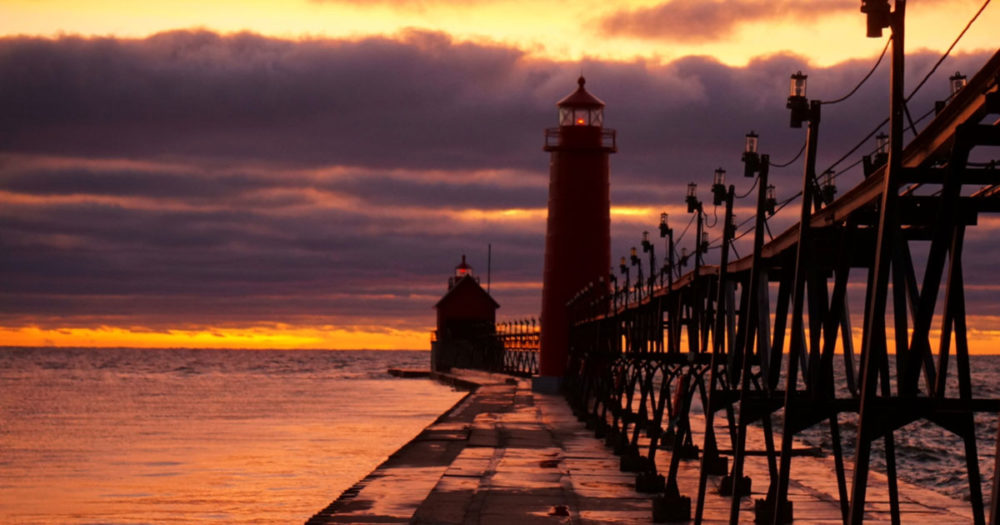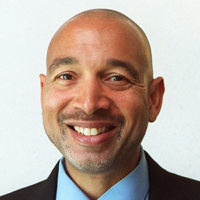Lake Michigan is not yet a hot tub, but the warming of this Great Lake gives you much to sweat about.
In his office at the University of Wisconsin Milwaukee, Paul Roebber, a Distinguished Professor in atmospheric sciences and a former editor of the journal Weather and Forecasting, showed me his most recent climate change lecture slides. The most arresting graphics compare current surface water temperatures of the Great Lakes with those three and a half decades ago. The average summer surface temperatures have risen 8 degrees Fahrenheit since 1980.
Particularly stark was Roebber pointing out a spot where a monitoring buoy floats way out in the middle of 100-mile-wide Lake Michigan, at a latitude between Milwaukee and Chicago. Two decades ago, average mid-July to September surface water temperatures in southern Lake Michigan ranged between 61 and 71 degrees. In 2016, they ranged between 67 and 77 degrees. On three separate days in 2016, temperatures hit 80. Surface water temperature changes near Milwaukee and Chicago were just as remarkable. On August 1, 1992, surface water temperatures were 61 and 65 degrees, respectively. On August 1, 2010, both were in the mid-70s.
“We’re starting to talk bath tub water and that is saying something about the changes,” Roebber said.
The future is almost unthinkable
Roebber’s comments certainly say something to me as a native of Milwaukee. I have vivid memories of childhood winters a half-century ago. We first- and second-graders were so acclimated to consecutive subzero days that when the high was 5 above, we’d walk to school with our coats flying open unzipped.

“We’re starting to talk bath tub water and that is saying something about the changes.” Atmospheric sciences professor Paul Roebber, University of Wisconsin.
Today, scientists predict a future climate unthinkable for a region where Green Bay Packers fans romanticize their home-team advantage in a stadium nicknamed the Frozen Tundra.
Roebber said that the modern lake warming has occurred with a rise of only a single degree in the air temperature over the Great Lakes over the last 30 years. But air temperatures are about to soar in scenarios where little or nothing is done to fight climate change. Researchers all around the Great Lakes and analysts at the Union of Concerned Scientists predict that the average summer highs of Milwaukee, currently about 80 degrees, could rise as high as 92 over this century.
The UCS analysis predicted that by 2100, Milwaukee would have nearly two months’ worth of days 90 degrees or higher, including three weeks’ worth of 100-degree scorchers. There would be at least one heat wave a summer with the sustained oppressive temperatures that killed hundreds of people in Chicago in 1995. Overall air quality would deteriorate as well, exacerbating asthma and other respiratory conditions.
In fact, the Upper Midwest region—including Milwaukee, Chicago, and Minneapolis—could collectively experience regular deadly heat waves with temperatures on the same scale that killed an estimated 70,000 people across Europe in 2003. “Under the higher-emissions scenario a heat wave of this magnitude would occur at least every fifth year by mid-century and every other year toward the end of the century,” the UCS analysis concluded.
Under worst-case scenarios, northern Illinois will have the climate of Dallas and southern Illinois will have the temperatures of Houston by the end of this century. As for Illinois’ neighbor to the north, Roebber notes, “Our climate in Wisconsin will look like Arkansas.”
Change is underway in the world’s largest surface freshwater system
It’s scary to contemplate what Lake Michigan could be compared to a century from now. The five Great Lakes comprise the world’s largest surface freshwater system, in a basin serving 30 million people. While many long-range projections of climate change along America’s eastern seaboard focus on chronic inundation from rising ocean levels, the lakes offer a different set of perplexing dilemmas.
Perhaps most perplexing is the year-to-year unpredictability of conditions. The general scenario of recent decades has been less ice cover in winter, which has allowed more water to evaporate and resulted in unprecedented low lake levels. But there can also be years where that trend is punctuated by ice-choked Great Lakes as the warming Arctic ironically creates a wavier jet stream.
The overall long-term trends, according to the University of Wisconsin Sea Grant Institute, point to all the bodies of water in the state being at risk.
“Longer, hotter, drier summers and increasing evaporation will result in warmer and shallower rivers, shrinking wetlands, and dried-up streams, flowages and wild rice beds,” the institute says. “Algal blooms will create anoxic conditions for aquatic life in ponds and many lakes.”
“These conditions will reduce the amount of suitable habitat available for trout and other cold-water fishes, amphibians and waterfowl. A two-degree rise in temperature could wipe out half of Wisconsin’s 2,700 trout streams. Hot dry conditions, coupled with more frequent thunderstorms and lightning, will increase the chance of forest fires. Red pine, aspen and spruce trees will disappear from our northern forests.”
A joint report by the University of Wisconsin and the state’s Department of Natural Resources predicts more climate-change losers than winners among fauna. As populations of European starlings, Canada goose, and gray squirrels grow, those of the purple martin, black tern, American marten, common loons, and various species of salamanders, frogs, and prairie birds may decline or disappear.
“This will result in a net loss to the state’s biodiversity and a simplification of our ecological communities,” the report said.
As for commercial activities, Roebber said there may be more ice-free days to allow more winter shipping, but fluctuating lake levels may play havoc with lakeshore-dependent businesses during the rest of the year, from expensive marina dredging operations to beach erosion in resort communities. Water quality may be degraded if low lake levels expose harmful chemicals. An additional wild card is the prospect of Wisconsin facing more weather extremes with heavy rains and floods dancing with more frequent short-term droughts.
“It’s not clear how much lower the lake will go, but the levels will become more variable,” Roebber said.
Sitting on our hands
This month, 13 federal agencies released the government’s latest major assessment that human activities are “the dominant cause” of the warmest period “in the history of modern civilization.” That report predicts a 9.5-degree rise in average temperatures in the Midwest under continued high-emission scenarios, the greatest rise of any region in the contiguous United States.
But it is not clear how much researchers will be able to refine their predictions. The Trump administration, despite approving the release of the congressionally mandated report, is in the midst of an unprecedented attack on climate change research. Climate change experts in the Interior Department have been reassigned. The Environmental Protection Agency has banned some scientists from speaking at climate change conferences. The Trump administration has proposed hundreds of millions of dollars of cuts to NASA and NOAA planetary and weather research that relates to climate change.
The assault is also at the state level. Last year, Wisconsin governor Scott Walker ordered state agencies not to comply with President Obama’s Clean Power Plan and his DNR removed references from its website saying human activities are the root cause. Despite its prior partnering with university researchers, the DNR currently says, “The earth is going through a change. The reasons for this change at this particular time in the earth’s long history are being debated and researched by academic entities outside the Wisconsin Department of Natural Resources.”
In this environment, exacerbated by years of prior Congressional budget cuts that constrict the chances of winning federal research grants, Roebber fears for the further erosion of the nation’s ability to protect lives and livelihoods with science.
Destructive weather events are virtually certain to increase. A report this fall by the Universal Ecological Fund calculates that weather events that currently cost the US $240 billion a year will increase to $360 billion annually over the next decade, the latter cost being equal to 55 percent of the current growth of the US economy.
“Facts used to be something we used to solve difficult things and innovate,” Roebber said. “Why the political process is now so destructive to such an important function of society and why the (political) climate has almost become antagonistic toward education is troubling. We’re sitting on our hands instead of accelerating the things we need to do.”

